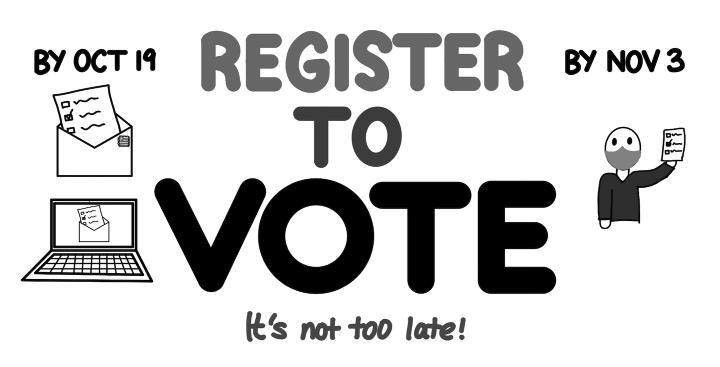Opinion
9 — Wednesday, October 14, 2020
The Michigan Daily — michigandaily.com
RILEY DEHR | COLUMN
Time to revitalize the environmental movement
I
shifted my car into neutral and drifted off I-80 in western Nebraska and into my hometown for a weekend visit. As he has done to thousands of travelers to enter North Platte, Neb., since 1963, a stern-faced Buffalo Bill glared down at me with a rifle in his hands from a 50-foot billboard. Behind him stands the famous Fort Cody, an imposing wooden building with plaster grizzly bears and mannequins guarding its doors. Inside is the story of the Wild West and its most famous celebrity, William F. Cody. Earning the nickname “Buffalo Bill” after killing approximately 4,000 bison in eight months, the hunter became an instrumental tool in the U.S. government’s mission to starve the area’s Native American tribes, who depended on the vast herds that once roamed the Great Plains. In his later years, he began the famous “Wild West Show” at his ranch on the outskirts of town, garnering worldwide, A-list celebrity status. European royalty and famous Westerners like Annie Oakley came here to dine with the world’s most famous man and hunt the now critically-endangered North American Bison. I went to his ranch, now a state park, later that night and admired the small herd of bison kept fenced up for events and tourist appeal. I looked out at the open fields behind them, scattered with grazing cattle, and couldn’t help but feel pity for the magnificent animals, lying in the mud in front of me in their small enclosure. Every North American Bison can trace its lineage back to the final 300 that escaped extinction — the last of 60 million that once roamed the Great Plains. Their tragic story is often recited as another regrettable American mistake of our past, but its lessons about extinction, and narrow escape from it, are more relevant today than ever. Fifteen thousand University of Michigan students and faculty marched through the streets on April 22, 1970, in the first celebration of a new holiday called Earth Day. Following in the footsteps of pioneers like Rachel Carson and Jane Goodall, the new environmental movement immediately had to confront a neverending and exponentially growing
list of long-existing issues. While the success of these battles is difficult to measure, it’s safe to say that the movement has been a general failure. Major issues like ocean acidification, deforestation, the collapse of biodiversity and over-use of resources have not yet been solved while newer threats like climate change, overfishing and politicization of environmental issues have been met with less than sufficient resistance. The result is the apocalyptic United States we now live in, where national disasters have forced Americans in California or Iowa or the Gulf Coast from their homes as climate refugees. Since the pandemic began, my newsfeed has been filled with an increasing number of terrifying studies and headlines that show just how bad things have truly become. Back in June, The New York Times released a report stating that over 500 species will likely go extinct in the next 20 years, a number of extinctions that would naturally occur over 16,000 years if not for the environmental issues impacting Earth. Since the 1970s alone, over 70% of the world’s animal populations have been wiped out, leaving more than a million species confronting extinction. These levels of biodiversity loss haven’t been seen since a meteor wiped out the dinosaurs 65 million years ago and are a sign that humanity’s efforts to grow sustainably have failed disastrously. The COVID-19 pandemic, which is itself the hypothesized result of poaching and wildlife trafficking, is perhaps the greatest example of what complications will continue to arise as we delete nature from existence. Since March, this disaster has killed over 200,000 Americans and made the world an increasingly dangerous and stressful place to live. One, often over-exaggerated, silverlining throughout all of this has been the worldwide drop in emissions and pollution due to national lockdowns. It was the first time in nearly a century, and the only time since the environmental movement began, that the world experienced a decrease in human activity and greenhouse gas emissions. Humanity received a rare opportunity to watch nature have a brief moment to breathe. Now, as the world has been set
back into motion, these benefits can seem like a distant memory, but they shouldn’t be treated as flukes of the pandemic. The changes needed to stop and reverse our current mass extinction will require a lot more than those COVID-19 forced upon us. Banning the sale of gasoline-powered cars, drastically altering our diets and subsistence farming are some of the few things that must be encouraged if we want to spare a million species from extinction and save millions of people who would otherwise be killed by the effects of a crumbling environment. The evidence is clear that we have built a flawed society that must be massively overhauled to deal with the realities of our world. With the largest nations in the world simultaneously deciding and legislating on how to recover, grow and develop to stimulate their economies, the pandemic could be the catalyst for this restructuring. Pioneering environmentalists must regroup, re-strategize and re-learn how to achieve environmental stability in a post-pandemic world. If we learn how to sufficiently influence policy, economics and psychology to encourage sustainable practices, then we might be able to avoid the various crises that currently await us. With many scientists warning that major changes must occur within the next 20 years, this may be our last chance. With more motivated, educated and talented people fighting for our environment than ever before, I am hopeful and terrified in equal measure. While Buffalo Bill went to great heights to inflict great environmental damage, almost every moment of our modern-day lives comes at the expense of another living thing. This lifestyle is one that has copied practices like his and emulated them on a mass scale, with an environmental footprint higher than any imaginable a century ago. Environmental ruin is not inescapable, but only if society uses this current moment of reckoning and inflection to confront it. Now, with the world at a crossroads, the environmental movement has the potential to solve these problems once and for all. Riley Dehr can be reached at rdehr@ umich.edu.
Design courtesy of Shannon Stocking
NOAH ENTE | COLUMN
I
n the Middle East, the month of September was marked by the signing of deals for peace and diplomatic relations between two countries, a very rare occurrence. In a part of the world marked by an extensive history of bloodshed, two agreements brokered by the U.S. and President Donald Trump were reached, with both the United Arab Emirates and Bahrain establishing official ties with Israel. The deals have made quite a splash on the world stage, and have even led Trump to receive nominations for the Nobel Peace Prize. These accords, signed by leaders of the three countries at a much-anticipated White House event, are sure to shift the regional dynamics and strategic reality in the Middle East for the benefit of all the signatory nations as well as the U.S. Unlike other notable agreements over the last 50 years, it appears that the accords signed in September could lead to full and harmonious relationships between Israel, the U.A.E. and Bahrain. Past deals between Israel and Middle Eastern nations, namely Egypt and Jordan, established what has mainly been “cold peace,” where the states
Design courtesy of Samuel Turner
LAURA MILLER | COLUMN
In the decision to revive fall football, Big Ten fails to acknowledge Title IX
W
ithin the Big Ten conference, including at the University of Michigan, women do not have an equal opportunity to participate in and benefit from college sports this fall when compared to men. Because of this, there is a compelling case to be made that the Big Ten is operating in violation of Title IX, which prohibits gender discrimination. Women and gender non-binary students who play fall women’s sports could potentially have strong Title IX claims against universities within the Big Ten. In making the unanimous decision to reopen football this fall, and football alone, the Big Ten doesn’t seem to be following the general wording of the Title IX of the Education Amendments Act of 1972, 20 U.S.C.§§1681 which states: “No person in the United States shall, on the basis of sex, be excluded from participation in, be denied the benefits of or be subjected to discrimination under any education program or activity receiving Federal financial assistance.” Right now, some male athletes can practice and play, but no female athletes have been given a comparable opportunity this fall. Players for the University of Iowa Hawkeyes football team rejoice in knowing that they will return to play Oct. 24, while teams like the Minnesota Golden Gophers women’s volleyball team fervently hope for the chance to do the same. There is uncertainty regarding the reinstatement and timeline of women’s fall sports following the NCAA announcement of spring championship dates. This has created an assumption that these sports will be played in spring — but with no clear plan from the Big Ten. Why wasn’t Title IX or equal opportunity considered by the Big Ten Return to Competition Task Force? The very same 14 university presidents in the Big Ten who voted unanimously to open conference football signed the National College Athletic Association Presidential Pledge: The Pledge and Commitment to Promoting Diversity and Gender Equity in Intercollegiate Athletics. This is remarkable because only 81.2% of Division I university presidents signed on to a pledge which largely promises to uphold existing civil rights laws. Setting law aside, the Big Ten presidents should be held accountable for failing to uphold this agreement.
An argument could be made that women aren’t being excluded from equal participation because they might get a chance to compete in the spring semester. This logic does not hold up well to Title IX statute text or case precedent. The “scheduling of games and practice time” is listed in the 34 C.F.R. § 106.41(c) as a way of measuring equal opportunity. The NCAA’s own handbook on Title IX compliance cites an example eerily similar to the current situation, which states that “institutions need to look at all sports.” The handbook continues with, “... if football is the only program brought back early, the fact that there is no like program will not excuse the school’s decision to bring back members of one sex and not the other.” Several past cases such as Parker v. Franklin County and McCormick v. School Dist. of Mamaroneck have established that scheduling disparities between male and female athletic competitions do in fact qualify as a denial of equal opportunity. One of the ways Title IX compliance is measured is by whether a disparity exists between men and women in varsity sports participation and making sure that this ratio is approximately proportional to the gender ratio of the student body at large; this was clarified in the case Cohen v. Brown. For example, the University of Michigan has a precise ratio of 50% male to 50% female undergraduate students, so athletic opportunities should match. Adding to the disparity, the men participating in football this fall receive more benefits than in a regular season. The same Title IX statute, as listed above, specifically lists the provision of medical services as a way by which to measure equal opportunity in intercollegiate athletics. Football players this fall not only will be able to receive daily antigen tests to help detect infection of COVID-19, but extensive cardiac support care in case of a positive test — including giving positive players easy access to cardiac MRI machines, even when none is available in the local area. The Big Ten press release regarding medical protocols amid football’s return did state that “eventually all Big Ten sports will require testing protocols before they can resume competition,” but it is unclear when those practices will be instituted across the board for athletes.
To fully comply with Title IX, one would expect an equivalent opportunity for female athletes. This has not happened. With statistics like these, every single woman or gendernon-binary varsity athlete could have a potential Title IX claim. A counter argument might be that football is a special case and thus should be looked at differently under Title IX. Football is a large source of revenue for universities, and so perhaps it is justified to treat this sport differently when considering COVID-19 reopenings given budget woes. However, this argument has implications beyond Title IX. The NCAA and member universities have vigorously defended lawsuits from male football and basketball players requesting adequate compensation for the use of their labor and likenesses by citing participation in an amateur sport. If the Big Ten defends Title IX claims with a “football is special” defense, this could undermine the avoidance of paying football players in other ways. The litigation regarding Title IX violations and COVID-19 has already begun, foreshadowing more to come. The seminal case Cohen v. Brown was recently reopened due to new allegations of Brown’s violation of the decades-old settlement due to COVID-19 budget cuts. On Sept. 25, 2020, a class action complaint was filed against the University of Iowa for providing inequitable access to athletic opportunities for women, a shortcoming further aggravated by eliminating the women’s swimming and diving program. We as students, alumni, community members and sports fans deserve answers. In responding to a crisis, which values are lost in rushed decision-making and why? Why did university presidents not act in accordance with their pledge to provide equal opportunities for women when they voted to reopen football? At the University of Michigan, will women and gender non-binary varsity athletes in fall sports file a class-action suit like their colleagues at the University of Iowa? Is the benefit of one partial season of football with a high risk of injury to players, including possible death, worth the consequences?
Arabia and Israel are established, the prospects for a two-state solution could be even greater. Palestinian officials may be more inclined to seriously come to the negotiating table once they realize that their cause is no longer a barrier towards growing Arab reconciliation with Israel. Additionally, Israel’s leaders may feel more secure in reaching an arrangement if they feel that their Arab allies will assure that the Palestinians honor their commitments and fully abide by the terms of a future peace accord. The strife between Israel and the Palestinians has its roots in a conflict that has spanned over a century. With no immediate end in sight, Riyadh should not wait for a resolution to strengthen its position in an everturbulent region. With these potential outcomes in mind, Salman should become the next in what will hopefully be a long list of leaders to take advantage of the opportunity to establish diplomatic relations with Israel. With full normalization, Saudi Arabia will be able to secure the economic and strategic benefits that come with having Israel in one’s corner, while taking a step
to promote the Israeli-Palestinian peace for which he has advocated for years. In international affairs, that certainly qualifies as a win-win situation, and Salman should not be afraid to make the move. Though normalization with Israel might not appear to be popular domestically, Saudi citizens will surely benefit from a strong, often like-minded partner, as well as the influx of foreign investment and financial opportunities. If such a deal also brings Israelis and Palestinians closer to a solution, few Saudis will be able to argue against it. In a region where violence often begets more violence, perhaps some peace will lead to even more peace. As states in and out of the Mideast continue to discover the advantages of making Israel into a friend, the House of Saud should waste no time in doing so itself. With threats mounting and a crisis developing around the globe, ties with the Jewish state will only increase Riyadh’s well-being and stability at home and abroad.
Laura Miller is a first-year student at the University of Michigan Law School and can be reached at llll@umich.edu.
The next step for peace primarily communicate about security issues and resource sharing but do not fully normalize relations. The nature of these ties has almost certainly been influenced by the history of war between Israel and its neighbors to the east and southwest. Yet though Bahrain and the U.A.E have been hostile to Israel for much of its statehood, neither state has ever actually gone to war against Israel. The warm peace officialized through the U.S.-brokered accords will allow the nations to develop public and private economic ties, defense cooperation and coordinated research and development in efforts to fight the COVID-19 pandemic. Considering these factors, it is clear that each of the three nations will benefit tremendously from full normalization. Reports have indicated that other countries in the region may be looking to follow in the footsteps of Abu Dhabi and Manama and establish diplomatic relations with the Jewish state. One such state which has increasingly been involved in rumors of Arab-Israeli cooperation is Saudi Arabia. At one point, it appeared that the Saudis would be the first Gulf state to foster ties with Israel, with its neighboring allies
following suit. Instead, the Saudi government curiously stands pat, with rumors of an impending SaudiIsraeli peace agreement continuing to surface. Among the reasons why officials in Riyadh may be holding out on establishing relations with Israel, perhaps the primary factor thus far has been the opinion of Saudi Arabia’s King Salman bin Abdulaziz. Over the years, the king has avidly promoted the creation of a Palestinian state alongside Israel, and has reiterated that a two-state solution to the Israeli-Palestinian conflict would be a precondition for full relations with Israel, as outlined in the 2002 Arab Peace Initiative. Salman has remained consistent in this position even recently, and all statements from him have indicated that Riyadh will hold out for the creation of a Palestinian state for official relations with Israel to get started. Salman’s vision has appeared at times to be quite different from that of hisson,CrownPrinceMohammedbin Salman. Last month, The Wall Street Journal reported friction within the House of Saud about whether to follow the U.A.E. and Bahrain’s lead and strike an agreement with Israel.
In his considerations, the crown prince appears to place high value in a possible relationship and sees Jerusalem as a key future ally in Saudi Arabia’s longstanding conflict with Iran. The Iranian regime considers both countries — as well as other Sunni Muslim states in the region — as bitter enemies and threats to its goal of a new Middle East, with Tehran as the center of power. Both Israel and Saudi Arabia have long dealt with Iranian proxies on their doorsteps that have overturned or destabilized local governments and significantly hurt populations in the area. Further, both nations are recipients of significant military aid from the U.S. With their common challenges and regional perspectives, a collaborative diplomatic relationship could be significantly beneficial for both states. To his credit, Mohammed has realized that if Saudi Arabia wishes to maintain and improve its standing in the region, it must look to any possible friends for support against the Islamic Republic of Iran, especially one with such substantial economic, technological and military prowess. It is also possible that after diplomatic relations between Saudi
Noah Ente can be reached at noahente@umich.edu.





